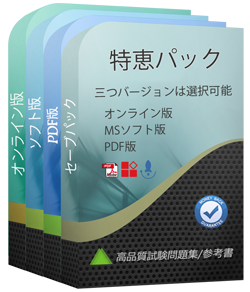あなたのテストエンジンはどのように実行しますか?
あなたのPCにダウンロードしてインストールすると、IBM C9550-413テスト問題を練習し、'練習試験'と '仮想試験'2つの異なるオプションを使用してあなたの質問と回答を確認することができます。
仮想試験 - 時間制限付きに試験問題で自分自身をテストします。
練習試験 - 試験問題を1つ1つレビューし、正解をビューします。
割引はありますか?
我々社は顧客にいくつかの割引を提供します。 特恵には制限はありません。 弊社のサイトで定期的にチェックしてクーポンを入手することができます。
更新されたC9550-413試験参考書を得ることができ、取得方法?
はい、購入後に1年間の無料アップデートを享受できます。更新があれば、私たちのシステムは更新されたC9550-413試験参考書をあなたのメールボックスに自動的に送ります。
あなたはC9550-413試験参考書の更新をどのぐらいでリリースしていますか?
すべての試験参考書は常に更新されますが、固定日付には更新されません。弊社の専門チームは、試験のアップデートに十分の注意を払い、彼らは常にそれに応じてC9550-413試験内容をアップグレードします。
C9550-413テストエンジンはどのシステムに適用しますか?
オンラインテストエンジンは、WEBブラウザをベースとしたソフトウェアなので、Windows / Mac / Android / iOSなどをサポートできます。どんな電設備でも使用でき、自己ペースで練習できます。オンラインテストエンジンはオフラインの練習をサポートしていますが、前提条件は初めてインターネットで実行することです。
ソフトテストエンジンは、Java環境で運行するWindowsシステムに適用して、複数のコンピュータにインストールすることができます。
PDF版は、Adobe ReaderやFoxit Reader、Google Docsなどの読書ツールに読むことができます。
返金するポリシーはありますか? 失敗した場合、どうすれば返金できますか?
はい。弊社はあなたが我々の練習問題を使用して試験に合格しないと全額返金を保証します。返金プロセスは非常に簡単です:購入日から60日以内に不合格成績書を弊社に送っていいです。弊社は成績書を確認した後で、返金を行います。お金は7日以内に支払い口座に戻ります。
購入後、どれくらいC9550-413試験参考書を入手できますか?
あなたは5-10分以内にIBM C9550-413試験参考書を付くメールを受信します。そして即時ダウンロードして勉強します。購入後にC9550-413試験参考書を入手しないなら、すぐにメールでお問い合わせください。
Tech4Examはどんな試験参考書を提供していますか?
テストエンジン:C9550-413試験試験エンジンは、あなた自身のデバイスにダウンロードして運行できます。インタラクティブでシミュレートされた環境でテストを行います。
PDF(テストエンジンのコピー):内容はテストエンジンと同じで、印刷をサポートしています。
IBM Operational Decision Manager Advanced V8.7 Application Development 認定 C9550-413 試験問題:
1. A rule task selects a package that contains the following rules:
The Priority property of those rules is set to the following values:
R1: 2
R2: 3
R3: 1
All three rules test the same object in their conditions and, at runtime, match instances of the object present in working memory. There is a requirement to have only instances of R1 fire in cases when more than one rule match.
Which rule task execution properties can the application developer use to meet this requirement?
A) Fastpath algorithm, Literal ordering, and Rule Exit Criteria
B) Fastpath algorithm, Default ordering, and Rulelnstance Exit Criteria
2. A car rental company offers the following discounts to customers who use their reservation rule application.
The discounts are cumulative and must be applied in the specified order.
*Frequent renter discount
*Hybrid or electric car discount
*Corporate account discount
An application developer has created a rule package for discounts, and has authored an action rule for each discount. The rule names match the names listed above.
The application developer creates a rule task and adds individual rules to 'Rule Selection1 in the required order.
How should the application developer configure the rule task for discount calculation so that the rules fire in the specified order?
A) Select 'Fastpath' algorithm and 'Default' ordering
B) Select 'Fastpath' algorithm and 'Priority' ordering
C) Select 'Sequential' algorithm and 'Literal' ordering
3. After a long period of inactivity, an execution request of the only ruleset deployed to Rule Execution Server is delayed.
Which change should the application developer make to avoid this problem?
A) Increase the memory allocated to the server.
B) Increase the engine pool size.
C) Set the ruleset maxldleTime property.
D) Activate asynchronous ruleset parsing.
4. A completed decision service used to make independent, stateless decisions is ready for integration. All IBM Decision Server components are installed and running. The application developer does not have access to deploy additional EAR files to the application server.
The application developer is considering the appropriate rule execution patterns to follow in developing the client applications.
Client Application 1:
* based on Java,
* will invoke the decision service on the same host Operating System environment as the decision service.
Client Application 2:
* will invoke the same decision service,
* location is a separate Operating System environment over a network connection.
Which rule execution invocation options should the application developer use?
A) Client Application 1: Remote, stateful EJB rule session (jrules-res-session-ejb3-<appserver>.jar) Client Application 2: Plain Old Java Objects (POJO) rule session (jrules-res-session-java.jar)
B) Client Application 1; Hosted Transparent Decision Service
Client Application 2: Java SE rule session (jrules-res-execution. jar)
C) Client Application 1: Java SE rule session (jrules-res-execution. jar) Client Application 2: Hosted Transparent Decision Service
D) Client Application 1: Plain Old Java Objects (POJO) rule session (jrules-res-session-java.jar) Client Application 2: Local, stateless EJB rule session (jrules-res-session-ejb3-<appserver>.j ar)
5. A mortgage company has the following rules for determining yearly interest rate based on loan duration (in years):
*< 5 years - 5%
*>= 5 years and <= 10 years - 5.8%
*>= 11 years and < 15 years - 6.5%
*>= 15 years and <= 20 years - 7%
*> 20 years-7.5%
An application developer has created a decision table to implement these rules. The table contains one condition configured to test 'loan duration is between <min> and <max>; Which of the following correctly expresses the condition '>= 11 years and < 15 years'?
A) [11 [15
B) [11 15]
C) ]11 [15
D) [11 15[
質問と回答:
| 質問 # 1 正解: A | 質問 # 2 正解: C | 質問 # 3 正解: C | 質問 # 4 正解: D | 質問 # 5 正解: C |


 クリック」
クリック」 弊社は製品に自信を持っており、面倒な製品を提供していません。
弊社は製品に自信を持っており、面倒な製品を提供していません。



 -上山**
-上山**

